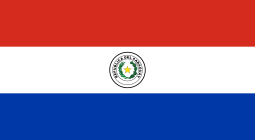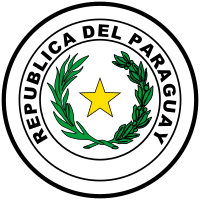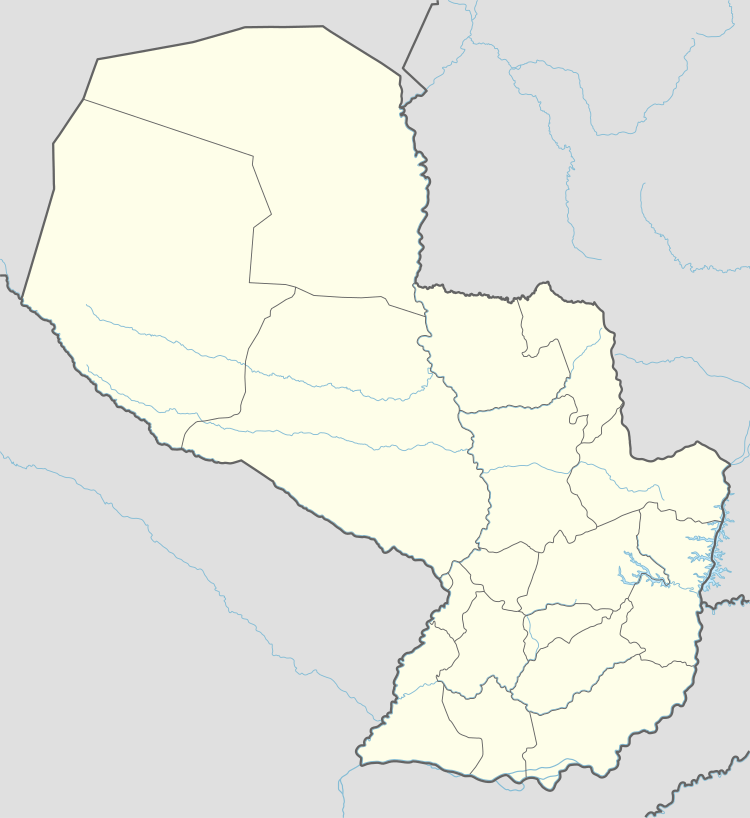Loma Plata
Loma Plata is a city in the district, distrito, of Department of Boquerón, Paraguay. It is located 407 km from Asunción by a paved detour of 22km from the Ruta Transchaco. It is the main town of the Menno Colony, one of the Mennonite colonies of the Paraguayan Chaco.
Loma Plata | |
|---|---|
City | |
 Flag  Seal | |
 Loma Plata Location in Paraguay | |
| Coordinates: 22°23′0″S 59°50′0″W | |
| Country | |
| Department | Boquerón |
| Founded | June 25, 1927 |
| Government | |
| • Intendente | Walter Stockel |
| Elevation | 133 m (436 ft) |
| Population (2008) | |
| • Total | 5,500 |
| Time zone | UTC-4 |
| • Summer (DST) | UTC-3 |
| Postal code | 9370 |
| Area code(s) | (595)(492) |
| Climate | BSh |
Climate
The temperature in summer reaches up to 44 °C and, in winter, can reach 0 °C. However, most winter days are fairly warm, though a jacket, long-sleeved shirt and pants are good to pack in the suitcase for a winter visit since the climate changes quickly. The average temperature is 26 °C. The rainy season is December through March; however, some years are very dry and others very rainy so the climate varies a lot.
History
In the 1760s Catherine the Great of Russia invited Mennonites from Prussia to settle north of the Black Sea in exchange for religious freedom and exemption from military service, a precondition founded in their commitment to non-violence. After Russia introduced the general conscription in 1874, about a third of the Russian Mennonites migrated to the US and Canada. The members of the Colonia Menno (of which Loma Plata is the largest town and administrative centre), settled first in Canada until a universal, secular compulsory education was implemented in 1917 that required the use of the English language, which the more conservative Mennonites saw as a threat to the religious basis of their community. 1743 pioneers came from Canada to Paraguay in 1927 and turned the arid Chaco into fertile farmland over the years. It was the first Mennonite colony in the region. Some years later more Mennonites immigrants arrived to the Chaco area from Germany and Russia and founded the Fernheim (1930) and Neuland (1947) colonies.
At the beginning, these pioneers had to overcome many adversities. Not only was their arrival not properly prepared as was previously promised by the Casado company because the settlement complex should have been surveyed and a railway constructed up to the settlement location, the settlement on the promised land was delayed 16 months and the immigrants were forced to stay in a preliminary, overpopulated camp in Puerto Casado before being able to move into the interior of the Chaco wilderness and the land they had bought for their settlement. Many became sick due to the lack of medical care, whereof 121 died, 75 of them being children under 14 years. Some 60 families returned to Canada.
Instead of riding up the railway to the settlement, the settlers were forced to travel with oxen vehicles on bumpy roads and under very primitive conditions. The gradual move to the settlement area started in April 1928. Some families then already lived in wilderness camps, still many lived in Puerto Casado. They entered a hostile wilderness with the aim of creating a new life for themselves. Throughout the settlement area, they formed 14 villages. Together they cleaned up the camps, constructed their houses, made roads and installed the first common buildings such as schools and church. Today the Menno Colony has about 9,000 inhabitants descendants of the first around 1,200 settlers. Together they form a multicultural society with indigenous people, Latin Paraguayans, Brazilians and a number of people from other cultural origins.
In 1937 Loma Plata emerged as the colony center and a colony office was built (currently the Post office). Loma Plata is a Spanish name. Some wanted to keep it, others again rejected it and wanted a German name instead. For this reason this place was renamed "Sommerfeld". After about a dozen years the Mennonites resorted back to the name Loma Plata and that was also the publicly recognized name.
Today Loma Plata is the main town of the colony and home to a thriving agricultural co-operative, La Cooperativa Chortitzer Ltda. with an impressive dairy and meat production. It is a modern town with shops, supermarkets, schools, churches etc.
Church
The first and biggest church building was built in Osterwick outside Loma Plata. Today there are several German speaking Mennonite churches as well as Spanish speaking Churches. Some examples of German speaking Churches are Emmanuelgemeinde, Elimgemeinde, Mennonitengemeinde, Bethelgemeinde, Hoffnung für Alle and Manoagemeinde (the newest addition to the German-speaking churches). Agua Viva is an example of a Mennonite Spanish speaking church. There are also Spanish/Portuguese speaking churches of Pentecostal origin.
Economy
Residents of Loma Plata are engaged in agriculture, livestock and industry. They are organized in La Cooperativa Chortitzer Ltda. There are large dairies in the region, about 5,000 persons living in Loma Plata. There are two large supermarkets and several smaller supermarkets and corner shops as well as hardware stores in Loma Plata. There is also a bookshop with German, English and Spanish books. There are many small clothes shops all over Loma Plata. At times, private people organize yard sales or auctions.
Health
Currently one of the 4 existing hospitals in the department of Boquerón is in Loma Plata, which serves all residents of the area. It was constructed in 1948. The work and costs were largely covered voluntarily and with donations. The first building had a size of 17x50 feet with a consultation room, a laboratory, a pharmacy and three rooms for patients.
Today the hospital in Loma Plata is a modern health facility and is part of the services provided by the Asociacion Civil Chortitzer Komitee. It is one of the most frequently visited hospitals of the Chaco. The services expanded a lot in the last years and keep expanding with new technology. It attends not only the colonists but also many indigenous people and Latin Paraguayans of the region. There are many family doctors working at the hospital as well as several full-time specialized employees. Outward specialists come to the colony on scheduled times throughout the year in order to provide a broad spectrum of services. The hospital provide good maternal care by specialists and with midwives assisting at birth.
There is a laboratory at the hospital as well as a private laboratory (Laboratorio Sawatsky) in Loma Plata. Loma Plata has a Nursing school where students can obtain a degree as a licensed nurse in cooperation with Universidad Evangelica de Paraguay.
There are also several private medical clinics in the town, some with doctors that work privately as well as in the hospital. There are many dentist clinics in Loma Plata with dentists who have finished a training at university level. Pharmacies are found on several places around Loma Plata and are all private, except the pharmacy at the hospital, which belongs to the Asociacion Civil Chortitzer Komitee.
Tourism
Loma Plata is an important commercial and industrial center and has the necessary infrastructure to receive visitors: hotels, restaurants and access to several places of great tourist attraction, for example: Campo Maria, Laguna Capitan, Chaco Lodge and others.
The tourist office is situated in a traditional building on the main street, north of the cooperative's supermarket. It is open Mon-Sat 7am-11.30am. The tourism representative is happy to give information about the places to visit in and around Loma Plata as well as giving tours. A very interesting and informative video about the colony, its inhabitants and development from the foundation in 1927 until today is available for tourists to watch.
Loma Plata has an excellent museum with an outdoor exhibit of early farming equipment and a typical pioneer house plus an outstanding photographic exhibit on the colony's history. Guided tours are given in German, Plattdeutsch,Spanish and English.
Guided tours are also given in the milk plant "Trebol" for those interested in knowing how the production of dairy products is carried out.
Visits can also be arranged to the meat works, Frigochorti, where the cattle is slaughtered and the meat is packaged or used for sausage production. The visitor can follow the whole process through glass windows. Visits to the Frigochorti have to be arranged together with the tourist office in Loma Plata.
As for handicrafts, bags and hammocks they are made of Caraguatá Enlhet in the indigenous community of Pozo Amarillo, located 70 km southeast of downtown Loma Plata. In addition, there are exhibited works in palo santo wood.
The Rodeo Club Isla Po'i, which belongs to the breeders' association in Colonia Menno, 1984, seeks to improve the quality of livestock production in the area. Annually, June 12, there is an exhibition where the regional production is shown. The members of the association are also working in the recovery of lagoons through open channels to facilitate the drainage of water at times of lots of rain and to clean saline soils.
In the Experimental Isla Po'i Chacra, studies and experiments are carried out in different areas of agriculture: cotton, peanut, sesame, tomato, as well as explaining the process of tillage, crop rotation and others. It is experimenting with the different species of pasture for livestock feed, fodder and tolerable soil, climate and other factors for livestock production. It also works with fruit trees and ornamental plants and trees native to the Chaco for reforestation.
Transportation
Loma Plata is accessible by a paved road 22 km long, branching off the Transchaco highway. Nasa and Golondrina provide bus services about three times a day from and to Asuncion. Loma Plata even has a small airport.
References
- Geography Illustrated Paraguay, Distributed Arami SRL, 2007. ISBN 99925-68-04-6
- Geography of Paraguay, First Edition 1999, Publisher Hispanic Paraguay SRL.